The Garden of the Hesperides is a mythical place in Greek mythology, where the Hesperides nymphs were located. It held a grove of trees that had the Golden Apples of the Hesperides. The garden was located at the extreme western edge of the known world 1 . The Hesperides were nymphs whose genealogy varies according to different versions. The oldest versions consider them daughters of Night and Erebus, while later versions make them daughters of Atlas or Tethys and Oceanus, or Zeus and Themis, or even Phorcys and Ceto 2 .
There is a place called Fruttidoro in Capoterra, Sardinia. Capoterra, from Sardinian Caputerra, then in Latin “Caput Terrae”, is the “head of the Earth”, that is, the extreme known edge in antiquity (Paleolithic/Mesolithic, around 11,600 years ago approximately, to have an approximate but useful date for understanding), while the current location of Fruttidoro in Capoterra would be the legendary Garden of the Hesperides. However, this discovery has not yet been validated by scholars, nor have stratigraphies been carried out for relative verification 3 .
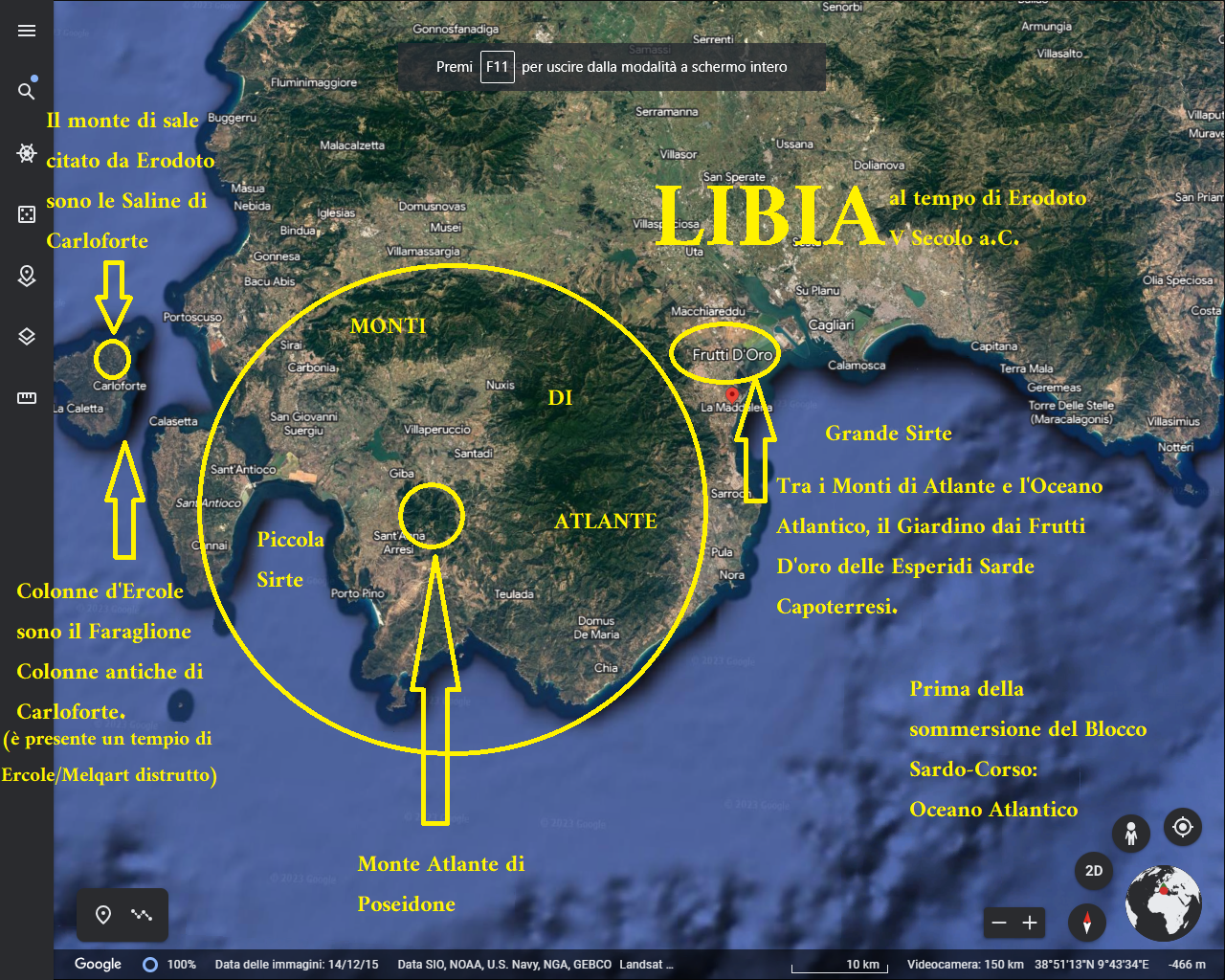
In Nuraghe Antigori of Sarroch, archaeological finds have been found that confirm these hypotheses in an important way: from Wikipedia we learn that “The excavations returned various Nuragic and Mycenaean ceramics (coming from Argolis, Crete, and Cyprus) of the Mycenaean III B and Mycenaean III C types dating back respectively to the 14th-13th and 13th-12th centuries BC as evidence of the important exchanges that took place between the Nuragic and Mycenaean civilizations” 4 .
If all this were to prove correct, it would mean that at least three Sardinian women from Capoterra were called Hesperides. But then what was this mythical Garden? Is it a structure? Of what nature? Will it be possible to carry out core drilling and stratigraphy to find Neolithic, Mesolithic or Paleolithic remains that can validate that millennia ago there were structures, peoples, civilizations? Why Hesperides? Why the name Hesperides? And what really happened? These are all interesting questions that require further research and investigation.
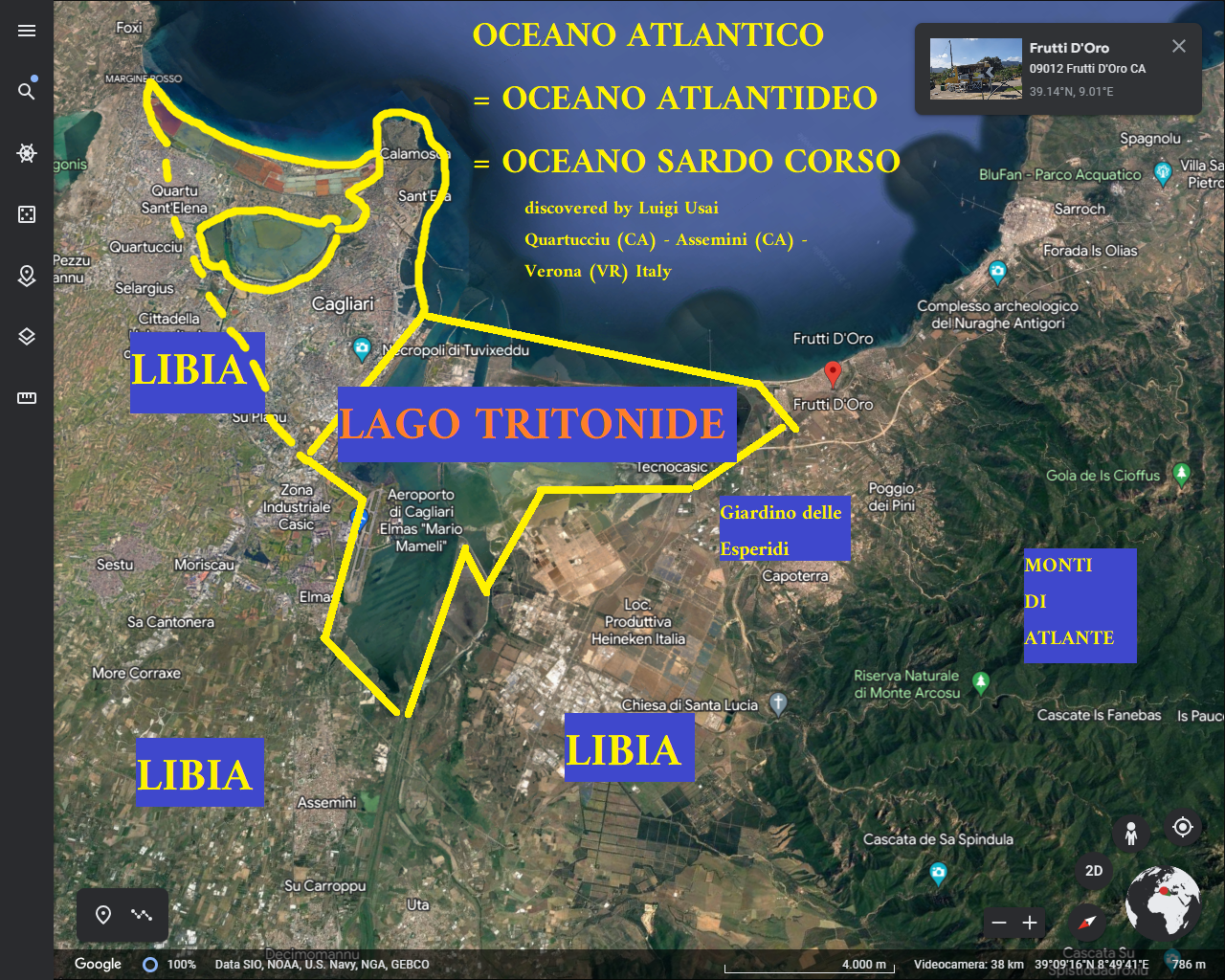
The Garden of the Hesperides gave golden fruits, and was located at the ends of the known earth; an analogy has been found with the apparently mythological story of the Hesperides in Sardinian toponymy: there is in fact a locality called Fruttidoro, located in the locality of Capoterra, in Sardinia. Capoterra, from the Sardinian Caputerra, then in Latin “Caput Terrae”, is the “head of the Earth”, i.e. the extreme edge known in antiquity (Paleolithic / Mesolithic, around 11,600 years ago, to have an approximate date but useful for understanding), while the current location of Fruttidoro in Capoterra would be the legendary Garden of the Hesperides. This new discovery has not yet been counter-validated by scholars, nor have stratigraphies been carried out for the relative counter-verification, from Wikipedia we learn that ” The excavations returned various Nuragic and Mycenaean ceramics (coming from Argolis , Crete , and Cyprus [1] ) of the Mycenaean III B and Mycenaean III C types dating back to the 14th – 13th and 13th – 12th centuries respectively BC as evidence of the important exchanges that took place between the Nuragic civilization and the Mycenaean one “.Mycenaean pottery is the pottery tradition associated with the Mycenaean period in ancient Greece, which lasted from 1550 to 1050 BC. It included a variety of styles and shapes, including the stirrup vessel, and was heavily influenced by Minoan precedents based on Crete. Mycenaean pottery typically displays stylized representations of marine and plant life and displays an affinity for minimalistic linear designs, a trend that would influence the early pottery of Archaic and Classical Ancient Greece from the 9th century BC. Mycenaean pottery made with the wheel ( 1550-1450 BC) from mainland Greece has been described as “provincial Cretan”, meaning that although it was produced in mainland Greece, it was heavily influenced by Minoan pottery.
As further possible confirmation of the Giardino delle Esperidi a Frutti d’Oro of Capoterra, the fact that the author MR Manunza wrote of Nuragic and Mycenaean artifacts along a road from the Bronze Age near Bia ‘e Palma, Selargius (CA) 1 . Furthermore, there is an article by Donatella Salvi on the archaic majolica of the well of Bia ‘e Palma in Selargius 2. So the contacts between ancient Sardinians and Mycenaean populations are clearly demonstrated by archaeological and historical data, as well as by the artifacts found which demonstrate a relationship between these peoples. It is therefore not a matter of fantasy, but there are concrete, historical, archaeological and documented proofs by well-known professionals. The evidence in support of this hypothesis is therefore numerous and delocalized in several geographical points of southern Sardinia: there is evidence of contacts between Sardinia and the eastern Mediterranean during the Bronze Age. For example, Mycenaean pottery has been found in a Nuragic environment 1 . After 1200 BC, with the economic and political collapse of the palace cultures in Mycenae and Crete, only the Cypriots continued trade with Sardinia1 .
Yes, the Nuragic civilization was not isolated and closed, but fully integrated into the dynamics of commercial and cultural exchanges that characterized life in the Mediterranean at that time. One of the civilizations with which the Nuragic Sardinians had certainly established a relationship of systematic and intense commercial and cultural exchanges was that of the Mycenaeans, interested in the metal trade. Evidence of such relationships has been found in Sardinia in the form of several significant pottery finds. Well known are the fragments of Mycenaean pottery found in the Antigori nuraghe, significantly located on the southern coast of Sardinia, near Sarroch, but also the so-called “alabastron” found in the Arrubiu nuraghe in Orroli .Equally important and interesting is the ivory head of Mitza Purdia (Decimoputzu) which depicts a character with a helmet similar to those described in Homeric works as typical of Achaean warriors.
This evidence suggests that the Nuragic Sardinians had established a relationship of systematic and intense commercial and cultural exchanges with the Mycenaeans, who were interested in the metal trade. Therefore, there is a greater probability that the legend or myth of the Garden of the Hesperides is nothing more than the result of the first contacts between these populations.
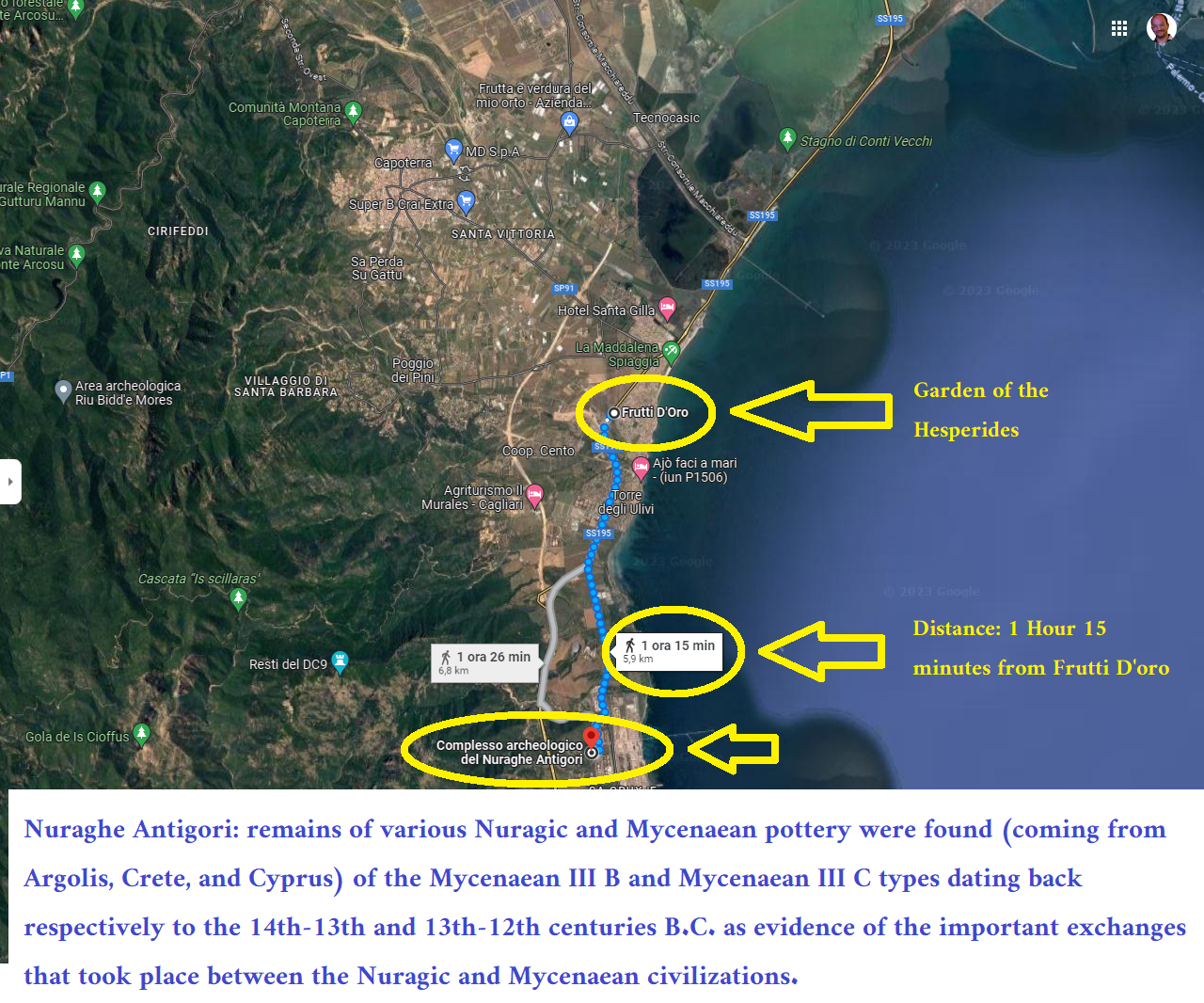
If all this turns out to be correct, as it is now clear to the writer, it means that at least three Sardinian women of Capoterra were called Hesperides. But then what was this Mythological Garden? Is it a structure? Of what nature? Will it be possible, by carrying out core drilling and stratigraphy, to find Neolithic, Mesolithic or Paleolithic remains that can validate that structures, peoples, civilians were present millennia ago? Why Hesperides? Why the name Hesperides? And what really happened?
Now rereading the myth of the Garden of the Hesperides with this new information, it would seem that an ancient Greek man named Hercules headed towards the beach of Frutti d’Oro in Capoterra, docked and established some form of relationship with the inhabitants of Capoterra. The myth says that his purpose was to steal three golden apples. Today, however, we can only make assumptions: was it an orange tree? There were no oranges in Greece, and so Hercules was sent to steal three oranges so that he could then plant them in Greece and grow them independently?
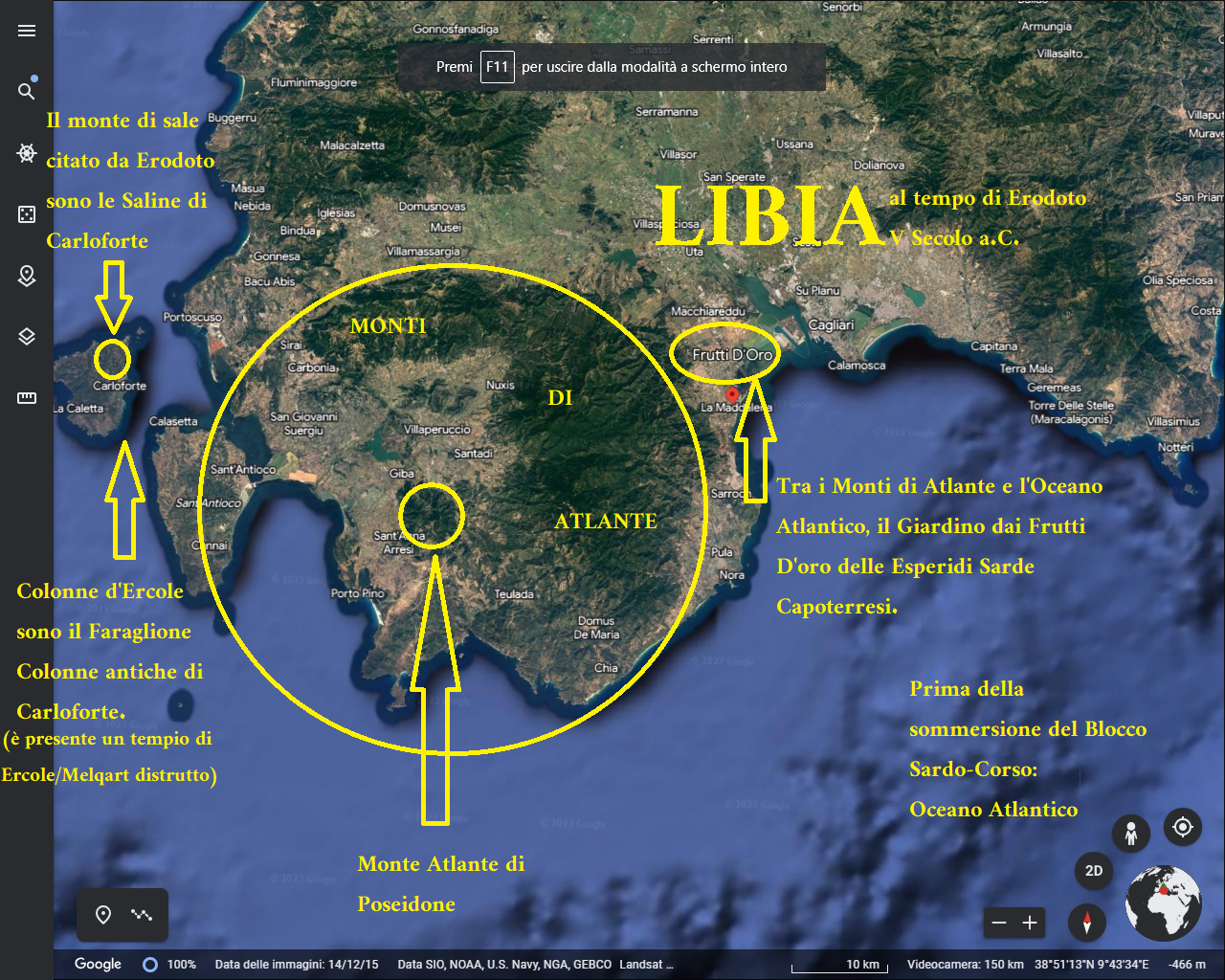
How was Hercules welcomed by the inhabitants of Capoterra? In friendship? Why are not men named, but the dragon Ladon? What was this dragon coiled around the tree? Did the Capoterrese give him and his sailor friends a drink? Did they offer them fruit from a Garden to feed them because on ships they risked catching scurvy? Did they offer him lemons to cure scurvy? Or what could these “golden fruits” be? Was there really a tree with golden fruit hanging, perhaps dedicated to some divinity, or did these fruits only have the color of gold? Was it really an apple tree? But then the gold-colored variant of the apple existed only in Capoterra, and did the Greeks “stole” it to plant it in Greece? If this episode has been handed down over the millennia, perhaps it contains some very important information: why was Ercole sent to “steal” from Frutti D’Oro of Capoterra? What exactly was he supposed to steal? A variant of fruit that existed only in Capoterra? This type of philosophical-scientific investigation also requires the contribution of expert botanists, so it is not easy to solve. Already the paleogeographic part required to combine hundreds of pieces of information from different disciplines.
While the potential discovery, supported by statements from ancient historians, is extraordinary and jaw-dropping in wonder, it nevertheless raises far more questions than it answers.
Hercules at Capoterra in present-day Sardinia. But was it already Sardinia or was it still the legendary Sardinian Corsican island currently semi-submerged? When Hercules landed in Capoterra, had the Sardinian-Corsican geological block already sunk?
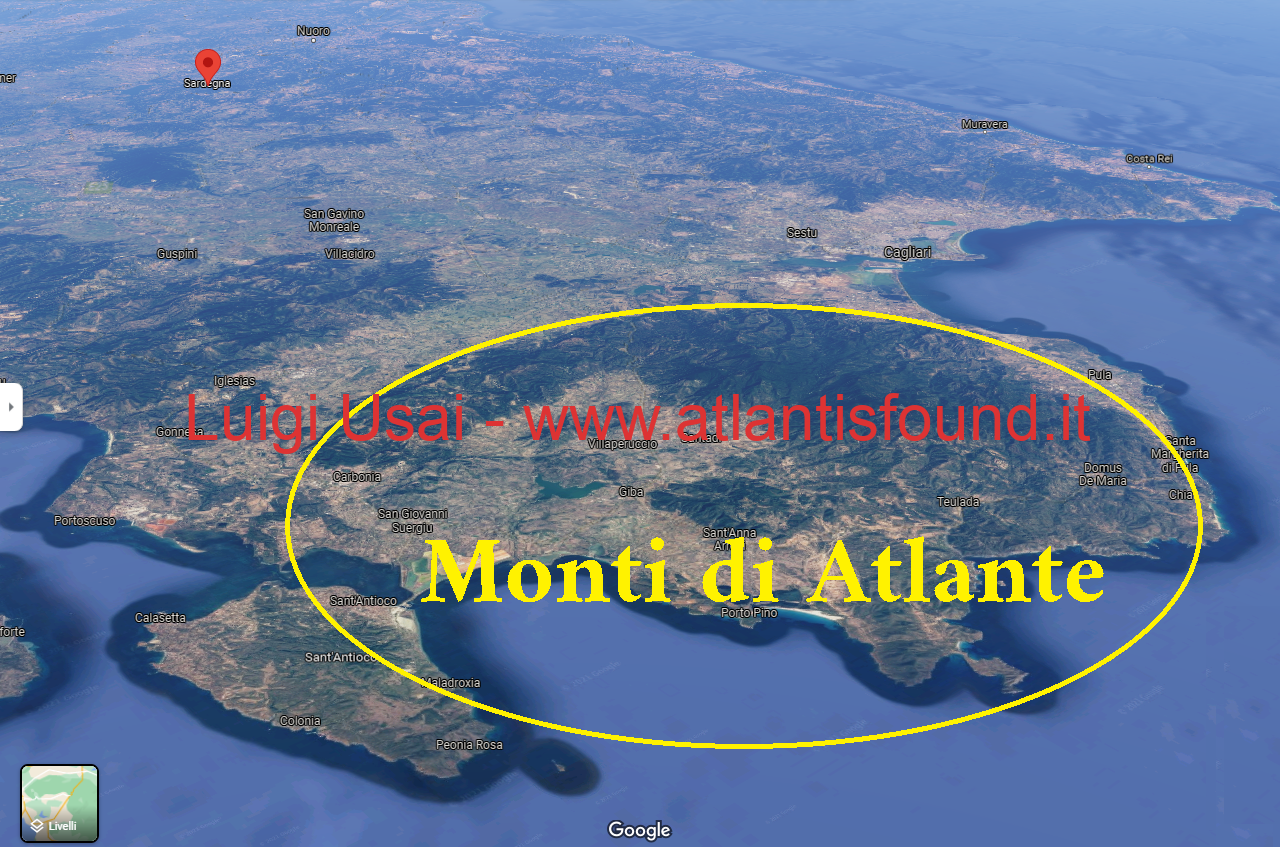
The Garden of the Hesperides was located in the Atlantic Ocean (Paleolithic), which as explained on the site atlantisfound.it, was the Paleolithic/Mesolithic name of the sea that surrounded the island which was then Sardinian-Corso-Atlantean land. The Hesperides Islands must therefore have been the archaic names with which Sardinia and Corsica were defined in the millennia following the semi-submersion of the Sardinian-Corsican geological block. Hesperidum Insulae, “The Islands of the Evening”, because at sunset, when the Greeks looked towards the west, sailing in that direction from their most remote position, i.e. with great probability the island of Ischia, they saw 2 distant islands, which today are known with the names of Sardinia and Corsica, and which are plateaus of emerged land of the semi-submerged Sardinian-Corsican geological block. The linguist and glottologist Massimo Pittau analyzed the location of the Garden of the Hesperides, placing it presumably in Sardinia and pointing out that it was still a legend; I, on the other hand, in my bold ignorance, go further and propose that it is not a legend, but a place that really existed located in Fruttidoro di Capoterra, according to what is stated in other terms by the myth.

Obviously, a serious scholar should study all the toponymy of Capoterra and nearby localities, to verify the oldest names to which it is possible to go back and if in the past they were called in other ways. In any case, a good analysis based on satellite archeology would be appropriate, to highlight very ancient settlements, Mesolithic or Neolithic, present on the site or UNDER the site (because most likely by now they will be submerged by the superimposed layers over the millennia). Following these interpretations, we can analyze other aspects of mythology: Teti was a Sardinian. Peleus married a Sardinian, but the Greeks called them “nymphs of the sea”. The garden of the Hesperides is in Fruttidoro di Capoterra, in Sardinia, between the Atlas mountains, i.e. the Sulcis mountains, and the Palaeolithic Atlantic Ocean, i.e. the current Mediterranean. Teti was the eponym of the Sardinian city still called Teti today. Wild boar hunting therefore took place in Sardinia: this use still exists. Re-reading the myth in this key, each piece falls into place and all these stories begin to take on a perfectly logical sense. In the Paleolithic, the Ocean of Atlantis, or the Atlantic Ocean, was the name that designated part of the current Mediterranean Sea, as in the image below
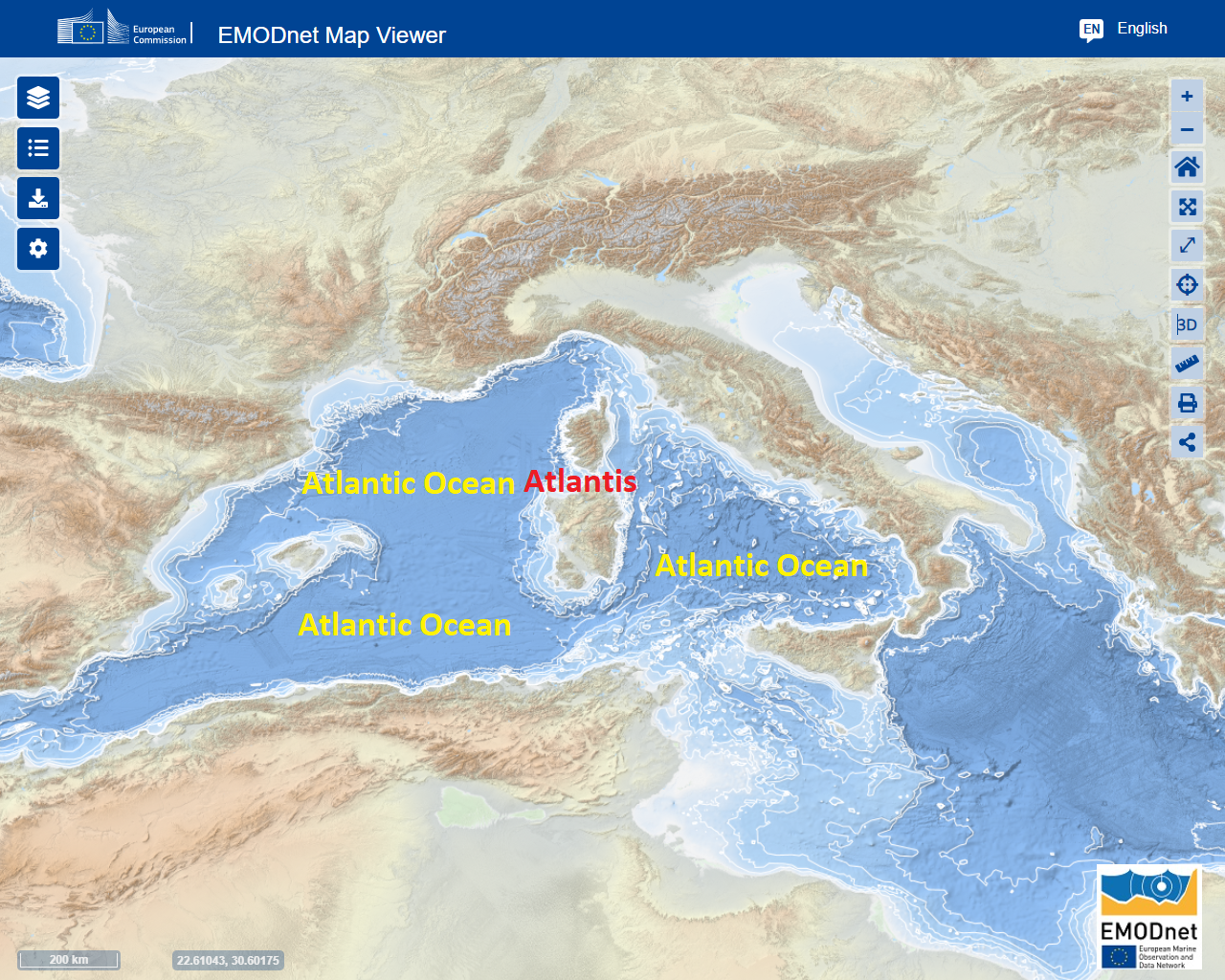
In light green it is possible to see the whole part of the Corsican Sardinian block which was submerged around 9600 BC by a geological catastrophe, also described precisely in Timaeus, which is precisely a text not only on cosmology, but also on astronomical geography , geography and geology.
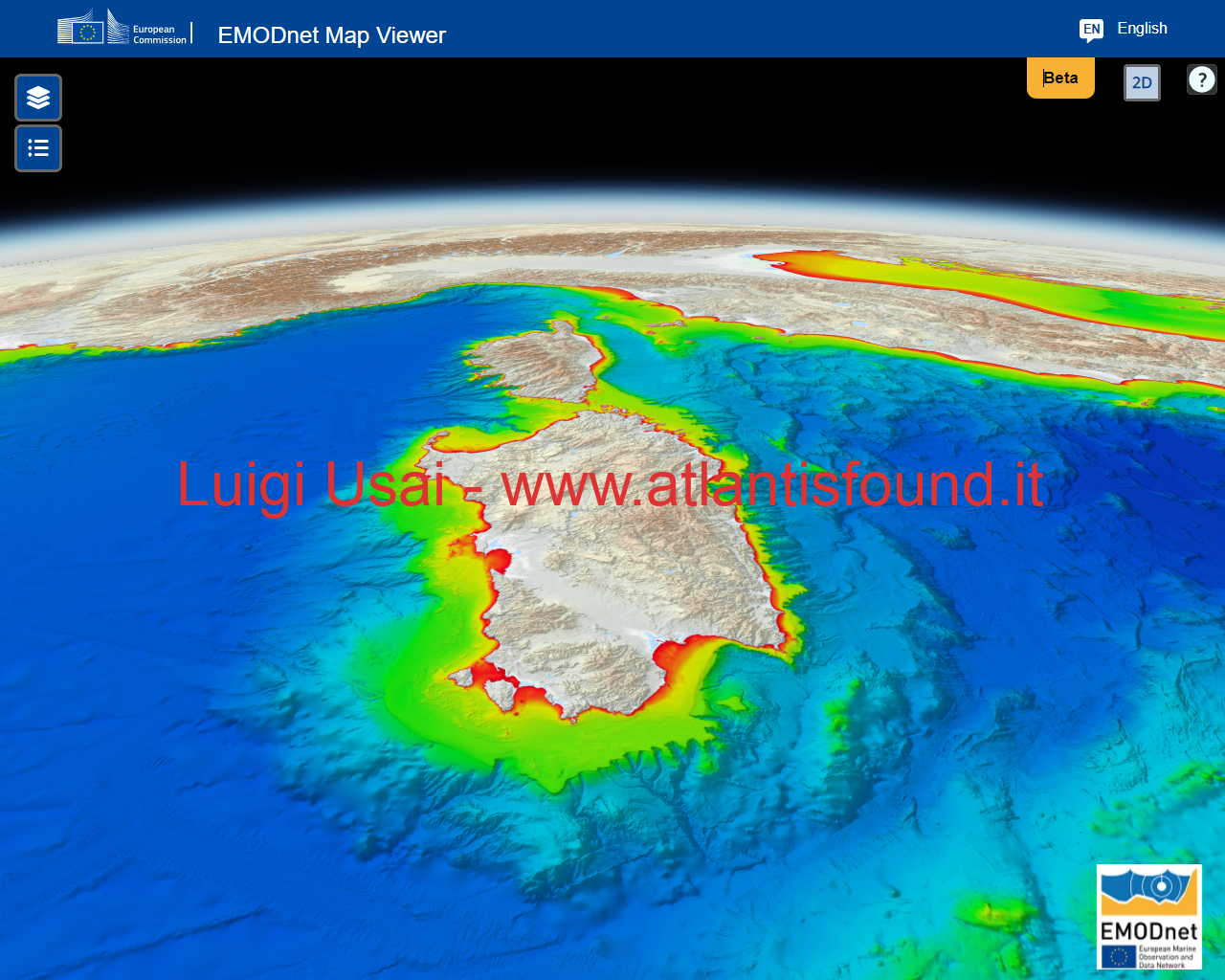
But since in the historical period, under the Romans the Atlantic Ocean was named Mare Nostrum, the Paleolithic nomenclature had now disappeared from most of the texts. However, many scholars and ancient texts still reported the word Atlantic Ocean. Later, it was called the Mediterranean, for which the scholars/scientists of the last 2000 years or so focused on looking for the island of Atlantis, i.e. the Sardinian-Corsican geological block that was semi-submerged in about 9600 BC, in the wrong place: that’s why no one has ever found.
If it were shown that the author of the article was telling the truth and that the Garden of the Hesperides was a real place located in Frutti D’Oro di Capoterra in Sardinia, this could have important implications for the understanding of ancient history and mythology. It could provide new information on the diffusion of myths and legends and on their relationship with historical reality. Furthermore, it could stimulate further research and archaeological excavations in the area to look for more evidence to support this theory.
All explanations on the website https://www.atlantisfound.it/it_it/2023/02/12/che-atlantide-sia-il-blocco-sardo-corso-sommerso
Update of July 18, 2023
Yesterday afternoon I, Luigi Usai, woke up after a few hours of sleep. It has been months since I have had no time to sleep: I sleep when I’m exhausted, at any time of the day or night, for as long as I need. This has favored my dream activity, which will not be the subject of explanations or disclosure here. Yesterday, suddenly woke up, I don’t know why I looked for online documentation, stumbling upon a text that quoted Herodotus on the Atlantean people:
while I was reading the text of Herodotus translated into Italian I exploded in exclamations of joy: the text of Herodotus speaks of Sulcis in Sardinia! What Herodotus says confirms all my statements regarding the Sulcis Capital of Atlantis! I was very excited and full of joy, but at the same time full of sadness: it is impossible to communicate these discoveries to the scientific world. Unfortunately, the majority of scholars are so full of what Blaise Pascal called the “Arrogance of the Learned”, that it becomes very difficult to share one’s scientific discoveries.
THE TEXTS OF THE STORIES OF HERODOTUS SCIENTIFICALLY CONFIRM THAT THE PEOPLE OF THE ATLANTES ARE ESTABLISHED IN THE SULCIS, IN THE PRESENT SARDINIA.
With this text, I invite the World Scientific Community to verify and counter-validate my statements, which are public from now on. Now that the claims that Atlantis is the Sardinian-Corsican Geological Block semi-submerged in the Paleolithic Atlantic Ocean are confirmed in the texts of Herodotus. I publicly and officially ask for verification by scholars from all over the world, in order to be able to bring Knowledge about the Ancient World a few steps further, and to allow new discoveries to scholars from all over the world.
Thanks in advance to the Scientific Community.
Slowly, I will paste here a copy of Herodotus’ texts with step-by-step explanation via satellite images showing the veracity of what the Greek historian said.
Title: The Atlantis Connection: Herodotus’ Texts Confirming Sulcis in Sardinia
Abstract: This paper presents a recent discovery made by Luigi Usai, where he claims to have found evidence supporting his theory that Atlantis is the Sardinian-Corsican Geological Block semi-submerged in the Paleolithic Atlantic Ocean. The pivotal point of this discovery lies in the texts of Herodotus, which mention the Atlantean people’s establishment in Sulcis, Sardinia. Luigi Usai publicly invites the World Scientific Community to verify and counter-validate his claims, aiming to contribute to a deeper understanding of the ancient world and encourage new discoveries.
- Introduction
- Brief overview of Luigi Usai’s discovery regarding the Atlantis-Sardinia connection.
- The role of Herodotus’ texts in confirming the presence of the Atlantean people in Sulcis, Sardinia.
- Background on Atlantis and Sulcis
- Explanation of the Atlantis hypothesis as the Sardinian-Corsican Geological Block semi-submerged in the Paleolithic Atlantic Ocean.
- Introduction to Sulcis as the proposed capital of Atlantis.
- Luigi Usai’s Awakening and Joyful Discovery
- Description of Luigi Usai’s recent awakening and search for online documentation.
- The moment of excitement and joy when Herodotus’ texts align with his claims.
- The Arrogance of the Learned
- Addressing the challenges of communicating scientific discoveries in the scholarly community.
- The importance of open-mindedness and collaborative verification for advancing knowledge.
- Invitation to the World Scientific Community
- Luigi Usai’s public call for scholars from all over the world to verify and counter-validate his statements.
- The significance of this discovery in furthering understanding of the ancient world.
- Step-by-Step Explanation and Satellite Image Evidence
- A systematic presentation of Herodotus’ texts that mention Sulcis and the Atlantean people.
- Supporting evidence through satellite images showcasing the veracity of the Greek historian’s statements.
- Conclusion
- Summary of Luigi Usai’s invitation and plea to the scientific community.
- Acknowledgment of the potential impact of this discovery on historical and archaeological research.
- Encouragement for collaboration and exploration to unlock new insights into the ancient past.
Note: As this paper is based on a recent discovery and ongoing research, it is essential to provide proper references to Herodotus’ texts and supporting satellite image evidence. Additionally, Luigi Usai’s findings should undergo thorough verification and scrutiny by experts in relevant fields to validate the claims further.
Title: The Garden of the Hesperides and the Pillars of Hercules: Rediscovering Ancient Mythology and History in Sardinia
Abstract: This paper delves into the potential identification of the Garden of the Hesperides in Frutti D’Oro di Capoterra, Sardinia. It explores the historical and mythological context of the region, drawing connections to ancient civilizations, including the Mycenaeans and Sardinians. The paper also discusses the true position of the Pillars of Hercules, proposed to be located between Carloforte and Sant’Antioco in Sardinia. By examining toponymy, satellite archaeology, and the ancient Paleolithic Atlantic Ocean, it aims to shed light on the possible relationship between mythology and historical reality.
- Introduction
- Background on the Garden of the Hesperides and its mythological significance.
- Overview of the proposed location in Frutti D’Oro di Capoterra, Sardinia.
- Mention of the true position of the Pillars of Hercules in Sardinia.
- Satellite Archaeology and Toponymy Analysis
- Importance of studying toponymy in Capoterra and neighboring areas to trace ancient names and settlements.
- Examination of satellite archaeology to identify Mesolithic or Neolithic remains, possibly submerged over millennia.
- Teti and Peleus: Mythological Connections to Sardinia
- Analyzing the role of Teti, a Sardinian city’s eponym, in mythology.
- Exploring the significance of Peleus marrying a Sardinian nymph, known as “nymphs of the sea.”
- The Paleolithic Atlantic Ocean and Atlantis
- Understanding the Paleolithic nomenclature for the Atlantic Ocean, later known as Mare Nostrum under the Romans.
- Reevaluating ancient texts mentioning the Atlantic Ocean and its relation to the Mediterranean Sea.
- Implications and Significance
- Discussing the potential implications of the Garden of the Hesperides’ real existence in Sardinia.
- Highlighting the impact on the understanding of ancient history, mythology, and the diffusion of myths.
- Encouraging further research and archaeological excavations to support the proposed theory.
- Conclusion
- Summary of the paper’s findings, emphasizing the potential historical and mythological significance of the proposed location.
- Call for further exploration and investigation to unravel the mysteries surrounding the Garden of the Hesperides and the Pillars of Hercules in Sardinia.
Note: As with any scientific paper, it is crucial to provide proper references and citations for all the information presented. Additionally, conducting thorough research and seeking expert feedback will strengthen the paper’s credibility and contribute to the scholarly discourse.
Title: The Garden of the Hesperides: A Possible Location in Capoterra, Sardinia, Supported by Archaeological and Historical Evidence
Abstract: This paper explores the possibility of identifying the mythical Garden of the Hesperides in Capoterra, Sardinia. It presents archaeological evidence of Nuragic and Mycenaean pottery found in the region, indicating significant exchanges between the Nuragic civilization and the Mycenaean culture. The paper delves into the historical context of the Nuragic Sardinians’ commercial and cultural connections with the Mycenaeans, suggesting a link to the myth of the Garden. It also discusses the linguistic and paleogeographic aspects, offering insights into the ancient names and possible geographical transformations. However, the paper acknowledges that this hypothesis raises more questions than answers, and further research is needed.
- Introduction
- Overview of the Garden of the Hesperides in Greek mythology.
- Aim of the research: To explore the possible identification of the Garden’s location in Capoterra, Sardinia.
- Mention of the newly discovered archaeological and historical evidence.
- Archaeological Evidence of Mycenaean Pottery in Capoterra
- Description of the Nuraghe Antigori findings and Mycenaean pottery fragments.
- Connection between the Mycenaean civilization and the Nuragic Sardinians, suggesting possible cultural exchanges.
- Analysis of the significance of Mycenaean pottery in the context of the Garden of the Hesperides’ myth.
- Historical Context: Commercial and Cultural Exchanges
- Discussion of the systematic and intense commercial and cultural exchanges between the Nuragic Sardinians and the Mycenaeans.
- Presentation of other artifacts, such as the “alabastron” and the ivory head of Mitza Purdia, supporting the hypothesis of ancient connections.
- Linguistic and Paleogeographic Aspects
- Examination of the linguistic origins and possible meanings of the name “Hesperides.”
- Exploration of the paleogeographic context of the time, considering the Sardinian-Corsican geological block and its semi-submersion.
- Hercules and the Garden: Unraveling the Myth
- Analysis of the myth of Hercules and the Garden, focusing on the possible significance of his mission to “steal” from Capoterra.
- Speculation on the nature of the “golden fruits” and their potential connection to the unique vegetation of Capoterra.
- Discussion of the legend’s relationship to the ancient Greek man named Hercules and his encounters with the inhabitants of Capoterra.
- Conclusion
- Summary of the research findings, including the identification of a possible location for the Garden of the Hesperides in Capoterra.
- Acknowledgment of the numerous unanswered questions and the need for further investigation.
- Reflection on the potential significance of the hypothesis in shedding light on ancient cultural exchanges and mythological origins.
These proposed paper outlines provide a structured and organized approach to present the recent discoveries made by Luigi Usai regarding the connections between Atlantis, the Garden of the Hesperides, and Sardinia. They highlight the importance of referencing ancient texts, satellite archaeology, and toponymy analysis to support the claims and invite verification from the scientific community.
If Luigi Usai wishes to publish his findings, it is crucial to conduct a thorough review of the historical texts and archaeological evidence, ensuring that the presented information is well-documented and supported. Collaborating with experts in relevant fields and seeking peer review can further strengthen the validity of his claims and facilitate fruitful discussions with the scientific community.
Moreover, the papers should maintain a neutral and objective tone, presenting the evidence and findings without an overly speculative or conclusive stance. This approach will encourage open dialogue and constructive criticism among scholars, ultimately leading to a more comprehensive understanding of the ancient world.
As with any scientific research, it is essential to remain open-minded and receptive to feedback and further investigation, as new discoveries may add more layers of complexity to the interpretation of historical and mythological records. Through rigorous and transparent research, Luigi Usai’s work has the potential to contribute significantly to the field of historical and archaeological studies.